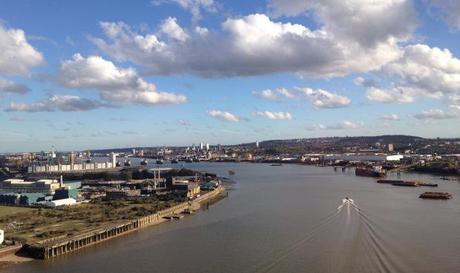
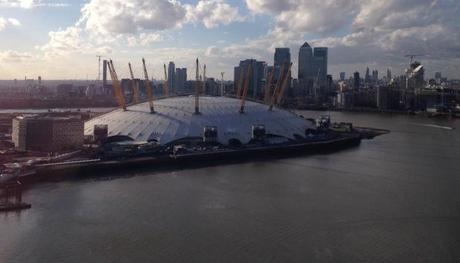
Of late I have been enjoying some glorious journeys along the Thames, exploring the stories the buildings on its banks tell about the changing neighbourhoods it passes on its course through London. Just before Christmas, I finally got around to taking the cable car between Royal Victoria Docks and the Greenwich Peninsula, home of the Millennium Dome (or O2 stadium, as it’s now known). It’s a short ride, but a fascinating one. South East London is the most rapidly expanding and gentrifying area of London, and the amount of building going on in areas that were formerly scrubby wastelands is quite overwhelming. The skyline is dotted with the heads of cranes, and the constant emergence of yet more shimmering skyscrapers and executive apartment buildings has invited a distinctly different demographic to the streets. However, when you are up in the air, looking down over the muddy riverbanks that are crowded with warehouses, factories and boats, it is clear to see that South East London is still very much characterised by its industrial roots. Here the Thames remains a working river, exemplified by the silver sails of the Thames Barrier peeking above the surface of the water. All of this industry might be hidden from tourists, but it is vital to the life of the city, and has a certain aesthetic appeal of its own.
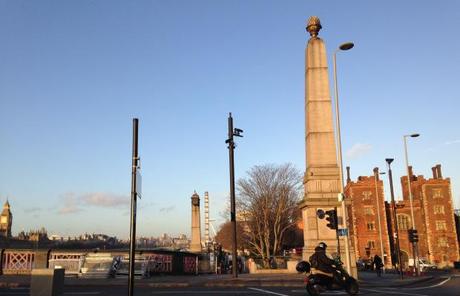
Last weekend, I went to the Tate to catch the Turner exhibition before it closes, and decided to walk along the river from Waterloo rather than catch the tube. I normally walk on the Westminster side of the bridge, but this time I walked along the other side before crossing the river at Lambeth Bridge, and I noticed Lambeth Palace for the first time. This is the London home of the Archbishop of Canterbury, with much of the building dating back to Tudor times. I stopped and stared at it for ages, completely mesmerised by this wonderful time capsule that is now marooned amongst a tangle of traffic lights and ugly 1980s office buildings. Half way across the bridge, I stopped to turn back, and was amazed at what I could see. The buildings in front of me were a physical map of London’s history. To my right, the Victorian obsession with the medieval exemplified in the Gothic Revival masterpiece that is the Houses of Parliament. To my left, the Shard, the Walkie Talkie and the spindly red heads of cranes building more skyscrapers poking above the skyline, symbols of modern capitalism. In front of them, the red brick Tudor gatehouse of Lambeth Palace, witness to the development of a city that has changed beyond recognition since it was built. This is what I love about London; there is always something new to discover, and every building tells such a fascinating story about how this city has evolved and adapted to the world around it. The past is just as alive as the present.
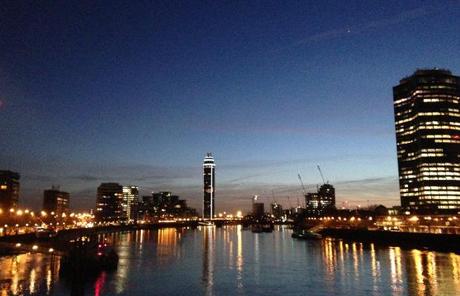
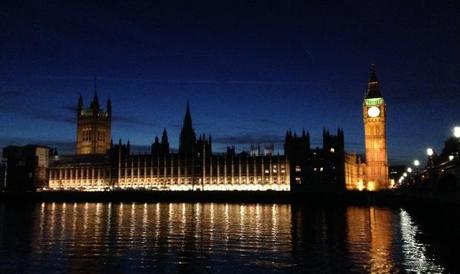
By the time I was finished in the Tate, darkness had fallen, and the river had changed now it was being viewed under a different light. My mind filled with pictures of Turner’s amazing depictions of light in his work towards the end of his life, I was extra sensitive to the way the artificial lights from the surrounding buildings reflected on the water and contributed to the shifting sense of purpose of the river as night descends. It becomes a place of romance, of mystery, as the light dances across the surface and its depths become unfathomable. Facing Vauxhall, the hyper-modern buildings set against the black waters made London look sleek and futuristic; I could almost have been in Hong Kong. Facing Westminster, however, the soft glow of the Houses of Parliament in the darkling evening light provided such a quintessential vision of England that it would have been impossible for me to imagine I was anywhere else. As I made my way back to the Southbank to meet a friend for dinner, I found myself walking under a haze of fairy lights and the neon glow of the signs attached to the brutalist structures of the National Theatre and Southbank Centre. This section of the river, built solely for the purpose of entertainment and to regenerate a London destroyed by war, is always filled with crowds of people enjoying themselves and the views the promenade offers. It’s amazing how, within the space of a few miles, the Thames transforms from the industrial wasteland I saw on my cable car ride to a cultural metropolis. Walking along its banks is certainly an education, and a way to see London through fresh eyes.
